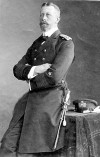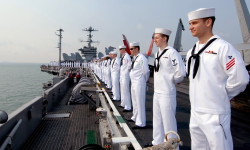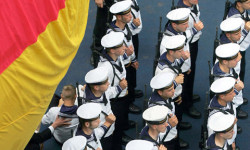The list of the ranks and remarks specified down refers to that approx. Conditions of 1914.
As is the case for the ranks of the imperial army the ranks of the navy differed likewise at the different shoulder pieces and Tressen at the sleeves. In addition further differences came like the shoulder flaps of the cover officers or the badges of the sergeants and crews on the left upper arm. As in the today's German Federal Armed Forces individual branches of service maintained September-guessed/advised distinguishing features in the form of certain caps, a Portepee, Tressen or the like, whereby to the respective organizational affiliation it addressed itself the colors of the Tressen (Metallgespinst) and buttons like e.g. Throwing divisions, offices for clothing or machine and fire master personnel of the torpedo department.
Crews (sailors)(Matrosen)
- Matrose (Sailor)
- Einjährig-Freiwilliger (one-year volunteer): Above open angle from double Wollschnur in the realm colors black silver (instead of knows) - red
- Obermatrose (seaman): Open above angle from edging, in yellow (to the blue uniform) or blue (white uniform)
As in the army which the one-year volunteer a rank does not separate a name for candidates of the reserve officer career.
Sailors and seaman contained during placed in front career designation besides the term guest (z. B. Painter guest, signal upper guest).
Sergeants without Portepee (leading seamen)(Maate)
- Maat (Leading seaman): Blue standing anchor (white uniform) with presented career badge. On blue sailor shirt and sailor jacket the emblem was in metal execution (gold or silver). Sleeve impacts of the jacket with Metalltresse set in
- Obermaat (upper leading seaman): like leading seaman, over the anchor additionally emperor crown with flying badges
The leading seamen and upper leading seaman were led in accordance with their career, for example as boat man leading seaman, carpenter leading seaman or an upper fireworks leading seaman.
Sergeants with Portepee (sergeants)(Feldwebel)
- Vize-Feldwebel bzw. Vize-Wachtmeister (Vice-sergeants and/or. Vice-being awake master): standing, clear anchor (metal) under emperor crown with flying volumes. Under the emblem an open above angle from Metalltresse. To according to standard carried the sailor jacket (Aufschlagtressen such as leading seamen) white shirt with high hitting a corner collar („parricides “) and transverse binder. Garrison cap of the cover officers. Be enough blue trousers and Halbschuhe. Officer sword with Portepee.
- Feldwebel bzw. Wachtmeister (Sergeants and/or. Constable): like vice-sergeants and/or vice-being awake master, additionally second chevrons under career badges; over the sleeve impacts rotating volume from metal chevrons („piston ring “)
Sergeant was a rank of the throwing divisions (naval services to country), Constable was a rank of the maritime service, which particularly supervised the departments under deck.
Portepee sergeants with more than 25 service years (starting from 1913 with 15 service years) put on the uniform of the cover officers with the badges of the Portepee sergeants. Since 1914 all Portepee sergeants, independently of the length of service, carried cover officer uniform with the badges for Portepee sergeants.
Cover officers (Deckoffiziere)
- Deckoffizier (Bootsmann, Steuermann etc.) (Cover officer (Boatswain, helmsman etc.): Service uniform similarly that of the officers, however flatter cap and crew practicing educator (exception: Vice-cover officers!). Instead of the shoulder pieces to all kinds of suit blue shoulder flaps with the career badge (for example unclear anchor at boat people, gear wheel with machinists) in metal execution. On the sleeve impacts of three horizontally arranged anchor buttons. Garrison cap similarly the officer head coverage, with lower cover and without oak leaves ring, over the Nationalkokarde (black, white, red) the emperor crown with flying crown volumes.
- Oberdeckoffizier (Oberbootsmann, Obersteuermann etc.) (Upper deck officer (Chief Petty Officer, Navigator etc.): like cover officer, however over the career badges on the shoulder flaps the emperor crown with flying volumes
Cover officers as officer deputies marked gold lace in the two sides of the pointedly approaching shoulder flaps.
Of vice-cover officers distinguishable were them on the basis shoulder flaps approaching trapezoidally from of them.
Officer candidate (Offizieranwärter)
- Seekadett (Sea-cadet (to 17. April 1899 cadet): Uniformly similarly the vice-sergeants, however without their Tressen and sleeve badges, in addition the sleeve impacts of the cover officers (with three anchor buttons). On the shoulders clips from black-red criss silver braid. Cap similarly the naval officer model, but flatter and without oak leaves embroidery around the Kokarde. Marinedolch without Portepee.
- Fähnrich zur See (petty officer (to 17. April 1899 sea-cadet): like sea-cadet, however Marine dagger with Portepee. Cap with oak leaves embroidery around the Kokarde. After existed officer examination officer sword alternatively to the Marinedolch permits.
- Vize-Deckoffizier (Vice-cover officer (until 1893: Vice-sea-cadet): until 1893 uniform just as the vice-sergeant, however sleeve badge without crown, on the shoulders braid clips as active officer candidates. Officer cap. To the uniform always officer swords (independent of existed officer examination, in contrast to practice with the candidates of the active career, sea-cadet and wo1). Starting from 1893 uniform such as cover officers, however officer practicing educators and officer garrison cap. Blue shoulder flaps to button-punching trapezoidally, laterally and above with Goldtresse set in. Career badge such as cover officer. Officer sword.
Sea-cadets and petty officer were naval officer candidates of the active career (career officer). Sea-cadets ranked between leading seaman and upper leading seaman. Petty officer to sea were located in rank between upper leading seaman and vice-sergeant, after existed officer examination however directly behind the sergeants.
Vice-cover officers were officer candidates of the reserve career. They ranked before the vice-sergeants/vice-being awake masters, however behind the sergeants/Wachtmeistern and the sword wo1s (with existed officer examination). Briefly first three reserve officer careers were open to them before outbreak of the First World War: the maritime service (vice-attendant), the naval artillery (vice-ammunition technician) and the engineer career (vice-machinist). 1915 came the sea-flier career in addition (vice-flight masters). Since the sea-fliers had no own officer corps, the reforwarding was made by the maritime service (second lieutenant to sea D. R.) or over the artillery career (second lieutenant D. R. the naval artillery). After existed officer examination vice-cover officers became also after 1893 umgs. still some time as vice-sword cadets designates.
Officers (Offiziere)
- Deckoffizierleutnant (Cover officer second lieutenant (cover officer engineer; introduced in January 1916): Naval officer or naval engineer cap. Silver one, black-red through-worked pieces of shoulder with the cover officer career badge. On the collar sides small gilded emperor crown with volumes
- Leutnant zur See (second lieutenant to sea (to 31. December 1898 Unterleutnant to sea): over sleeve impacts rotating narrow Metalltresse; frayless Epauletten and/or. Shoulder pieces from four together sewn, black-red durchzogenen silver flat cords
(as at the Landheer) (without rank star)
- Oberleutnant zur See (First lieutenant to sea (to 31. December 1898: Second lieutenant to sea): middle latitude sleeveless lace; Epauletten with thin fraying,
shoulder pieces such as second lieutenant (1 star)
- Kapitänleutnant (captain second lieutenant): two middle latitude sleeveless lace; Epauletten with thin fraying, shoulder pieces such as second lieutenant (2 stars)
- Korvettenkapitän (lieutenant commander): three middle latitude sleeveless lace; Epauletten with close fraying and/or. twisted shoulder pieces from
black-red criss silver cord (without star)
- Fregattenkapitän (Commander (designation imported to 23. November 1898): four middle latitude sleeveless lace; Epauletten with close fraying,
shoulder pieces such as lieutenant commander (1 star)
- Kapitän zur See (captain to sea): four middle latitude sleeveless lace; Epauletten with close fraying, shoulder pieces such as lieutenant commander (2 stars)
The designation commander replaced lieutenant commander with lieutenant colonel rank. Cover officer second lieutenant and/or. Cover officer engineers were officers without patent and came out from the cover officers.
Admirals (Admirale)
- Konteradmiral (Countering admiral (to 31. December 1898: Contreadmiral): a broad Ärmeltresse, over it a middle latitude sleeveless lace; Epauletten with thick fraying and/or. twisted shoulder pieces from two gold cords and a centrically set in black-red criss silver cord (without star)
- Vizeadmiral (Vice Admiral): a broad sleeveless lace, two middle latitude Tressen; Epauletten with thick fraying, shoulder piece such as countering admiral (1 star)
- Admiral: a broad sleeveless lace, three middle latitude Tressen; Epauletten with thick fraying, shoulder piece such as countering admiral (2 stars)
- Großadmiral (large admiral): a broad sleeveless lace, four middle latitude Tressen; Epauletten with thick fraying, shoulder piece such as countering admiral (crossed command staffs)
You can find the right literature here:
The Imperial German Navy of World War I

The Imperial German Navy of World War I, Vol. 1 Warships: A Comprehensive Photographic Study of the Kaiser’s Naval Forces Hardcover – December 28, 2016
The Imperial German Navy of WWI is a series of books (Warships, Campaigns, & Uniforms) that provide a broad view of the Kaiser's naval forces through the extensive use of photographs. Every effort has been made to cover all significant areas during the war period. In addition to the primary use of photographs, technical information is provided for each warship along with its corresponding service history; with a special emphasis being placed on those warships that participated in the Battle of Skagerrak (Jutland). Countless sources have been used to establish individual case studies for each warship; multiple photos of each warship are provided. The entire series itself is unprecedented in its coverage of the Kaiser's navy.
German Battlecruisers of the First World War
The 'ShipCraft' series provides in-depth information about building and modifying model kits of famous warship types. Lavishly illustrated, each book takes the modeler through a brief history of the subject class, highlighting differences between sisterships and changes in their appearance over their careers. This includes paint schemes and camouflage, featuring color profiles and highly-detailed line drawings and scale plans. The modeling section reviews the strengths and weaknesses of available kits, lists commercial accessory sets for super-detailing of the ships, and provides hints on modifying and improving the basic kit. This is followed by an extensive photographic survey of selected high-quality models in a variety of scales, and the book concludes with a section on research references - books, monographs, large-scale plans and relevant websites.
This volume is devoted to the famous ships of Admiral Hipper’s First Scouting Group. Slower but more robust than their British equivalents, German battlecruisers enjoyed a reputation for absorbing punishment, and although Lutzow was sunk at Jutland, Seydlitz and the rest of the Scouting Group survived heavy damage. This book concentrates on the seven completed ships but coverage extends to the ‘proto-battlecruiser’ Blucher and the ships building or designed by the end of the war.
German Surface Raider Warfare: the Ships and Operations of the German Imperial Navy During the First World War

German Surface Raider Warfare: the Ships and Operations of the German Imperial Navy During the First World War, 1914-18 Hardcover – April 19, 2017
The creation of surface merchant raiders by the Imperial German Navy at the outset of the First World War, was an innovative departure from the traditional practices of naval fleet operations. These ships had originally been merchant vessels and at first sight remained so. However, they were the definitive ‘wolves in sheep’s clothing’, for they carried beneath their disguises, which could be dropped when a target vessel was in close range, a formidable array of weaponry which included naval guns, torpedoes and mines. Some carried their own reconnaissance seaplanes and crews. This was a bold tactical initiative for these ships, acting independently, had missions that in many respects were destined to be ill fated. Their task was to do as much damage--principally to merchant ships carrying materiel for the Allied cause—as they could without (or before) being caught by the warships that were seeking to destroy them. Inevitably some were quickly sunk, or eventually beached or scuttled, and others were forced into neutral ports where they were interned for the duration of hostilities. Some, such as the SMS Wolf, were, however, phenomenally successful, and returned to their home ports to popular acclaim as romantic latter day buccaneers. This Leonaur book is based upon writings collated by the British Admiralty after the war, which was, in turn, gathered from German sources within the history of the activities of the Imperial German Navy. The book describes each vessel and details its voyages and battles, together with interesting operational and logistic information. Included in this Leonaur edition, to enhance the text for modern readers, are many pictures not included in any of the original texts.
Leonaur editions are newly typeset and are not facsimiles; each title is available in softcover and hardback with dustjacket; our hardbacks are cloth bound and feature gold foil lettering on their spines and fabric head and tail bands.
The War in The North Sea: The Royal Navy and the Imperial German Army 1914-1918

The War in The North Sea: The Royal Navy and the Imperial German Army 1914-1918 Hardcover – January 19, 2017
For years before the outbreak of the First World War, it was the expectation of most officers of the Royal Navy and the Imperial German Navy that very shortly thereafter; a decisive fleet action would be fought. This had a major impact on the strategic thinking on both sides of the North Sea. In fact, the unalterable geographic situation meant that for the Grand Fleet in its Scottish bases, the correct course to follow was not to seek a major fleet encounter. Essentially, it was by staying where it was that it could neutralise the High Seas Fleet and enforce an economic blockade of Germany.
The history of the war in the North Sea between 1914 and 1918 is a record of the attempts to break the deadlock - and it is also the history of the men who led the British and German navies. On both sides, the stresses of the huge burden which they bore led to a serious breakdown of trust in each other on the part of the admirals charged with the responsibility. Still more serious was the mutual loss of confidence between the admirals on the one hand and the politicians on the other; their letters and diaries reveal the bitter personal disputes that arose between them. The principal naval battle of Jutland occurred when the two most powerful fleets that the world had ever known clashed, almost by accident, in the North Sea on 31 May 1916. The outcome of the battle has prompted a minute examination of the tactics employed by the commanders, and a continuous debate as to who won, as well as a bitter controversy between the supporters of Sir John Jellicoe (the commander-in-chief of the Grand Fleet) and Sir David Beatty (the commander of the battle cruisers). Most British historians claim the battle as a British victory - a view which this book questions. It has been often suggested that after Jutland, the High Seas Fleet remained in harbour for the rest of the war, but as this book shows, the underrated Admiral Reinhard Scheer (its commander-in-chief) subsequently launched a number of major sorties. It was a series of chances that had determined the outcome of Jutland - and it was chance that repeatedly intervened to prevent a decisive encounter subsequently.
This book reviews the entire course of the war in the North Sea, from the first contacts between the fleets in the early days, to the ambitious (but abortive) mission planned at the end of the war for the High Seas Fleet - and, as a dramatic epilogue, its scuttling in Scapa Flow.
From Imperial Splendor to Internment: The German Navy in the First World War

From Imperial Splendor to Internment: The German Navy in the First World War Hardcover – July 15, 2015
This important work describes how the Imperial German Navy, which had expanded to become one of the great maritime forces in the world, proved, with the exception of its submarines, to be largely ineffective throughout World War I. The inactivity of the great Imperial Navy caused deep frustration, particularly among the naval officers. Not only were they unable to see themselves as heroes, they were also ridiculed on the home front and felt profoundly humiliated. With the exception of the one sea battle at Jutland, their ships saw little or no action at sea. Morale collapsed to a point where, at the end of the war, the crews were in a state of mutiny. The order that forced the fleet to go to sea against the British in 1918 was driven by a sense of humiliation, but because the German sailors wanted no part in such madness it triggered a revolution.
German Battlecruisers of World War One: Their Design, Construction and Operations

German Battlecruisers of World War One: Their Design, Construction and Operations Hardcover – November 4, 2014
This is the most comprehensive, English-language study of the German Imperial Navy's battlecruisers that served in the First World War. Known as Panzerkreuzer, literally "armored cruiser," the eight ships of the class were to be involved in several early North Sea skirmishes before the great pitched battle of Jutland where they inflicted devastating damage on the Royal Navy's battlecruiser fleet. This book details their design and construction, and traces the full service history of each ship, recounting their actions, drawing largely from first-hand German sources and official documents, many previously unpublished in English.
This post is also available in:
 Deutsch (German)
Deutsch (German)  Français (French)
Français (French)  Italiano (Italian)
Italiano (Italian)  简体中文 (Chinese (Simplified))
简体中文 (Chinese (Simplified))  Русский (Russian)
Русский (Russian)  Español (Spanish)
Español (Spanish)  العربية (Arabic)
العربية (Arabic)

















